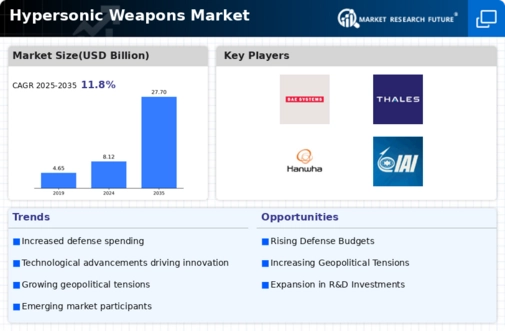Market Trends
Key Emerging Trends in the Hypersonic Weapons Market
The market for hypersonic weaponry is leading the way in contemporary military technology, with revolutionary developments reflecting the goal of achieving previously unheard-of missile system speed and maneuverability. Countries are realizing the strategic benefits of hypersonic weapons, and the competition for military supremacy, scientific advancement, and geopolitical concerns are influencing the market dynamics. The concentration on research and development to reach hypersonic speeds—generally defined as velocities surpassing Mach 5—is one notable trend within the hypersonic weapons market. This entails improvements in materials, aerodynamics, and propulsion systems to meet the particular difficulties brought on by traveling at high rates of speed. The need to breach complex adversary defenses, engage targets faster, and have faster reaction times is what's driving the rush to create hypersonic capabilities. The market for hypersonic weapons is significantly shaped by geopolitical factors, since major world powers extensively invest in the technology in order to establish their supremacy and scare off potential adversaries. The expanding number of countries actively pursuing or advancing their hypersonic projects is indicative of the growing strategic significance of hypersonic weapons. The perceived benefits of hypersonic abilities in strengthening a country's military capability and expressing power in contested areas are reflected in this trend. Geopolitical issues have a huge impact on the marketplace for hypersonic weapons because major world powers heavily devote themselves to the technology to cement their dominance and frighten off possible enemies. The growing strategic importance of hypersonic weapons is demonstrated by the increasing number of nations actively researching or improving their hypersonic initiatives. This trend is a reflection of how advantageous it is thought to have hypersonic capabilities for boosting military might and establishing dominance in contested areas. With variants that may be fired either the skies, the ground, or the sea, hypersonic weapon systems have grown increasingly prevalent on the market. The trend stated above emphasizes how versatile hypersonic weapons are, allowing them to be used on multiple platforms to address a variety of operational situations. Having the capacity to fire hypersonic missiles from various platforms improves a country's ability to carry out coordinated and integrated operations, giving decision-makers adaptable and quick-thinking strategic alternatives. Furthermore, a noteworthy feature in the hypersonic weapons market is the emergence of international collaboration and collaborations. Realizing how difficult and expensive it will be to create hypersonic technologies, nations are looking into joint ventures to pool resources, knowledge, and research efforts. Partnerships are intended to shorten development schedules, lower program expenses, and promote cooperation between allies with hypersonic capabilities. The industry for hypersonic weapons is also being shaped by the combination of artificial intelligence (also known as AI as well as sophisticated guiding systems. Algorithms driven by AI enable more accurate targeting, self-governing decision-making, and enhanced mission efficacy. These weapons are extremely lethal and accurate, and their unique combination of hypersonic velocity and AI-guided guidance makes them valuable tools in contemporary warfare. The industry is seeing attempts to tackle the difficulties involved in developing hypersonic weapons, such as problems with navigation, control, and materials resistant to harsh environments. Continuous testing and research are being conducted to address these issues, which is fostering development in hypersonic technology. Furthermore, developments in manufacturing techniques and materials science are essential for creating structures that can endure the extreme heat produced during hypersonic flight. The market for hypersonic weapons is subject to legal and arms control restrictions, identical to any other developing technology. Governments are debating whether or not to create international guidelines and accords to control the creation, testing, and use of hypersonic weapons. The aforementioned trend indicates an increasing consciousness of the possible strategic ramifications and the necessity of conscientious governance in the dynamic domain of hypersonic capabilities. To sum up, the market for hypersonic weapons is rapidly changing due to a variety of factors including technological advancements, international cooperation, platform diversity, geopolitical competitiveness, AI acceptance, and regulatory concerns. The current market trends underscore the intricate interaction of elements influencing the development of hypersonic weapons, as their capabilities become increasingly crucial to contemporary military strategy. The market's continued advancements highlight how important it is to reshape the nature of strategic rivalry and conflict in the twenty-first century.









Leave a Comment